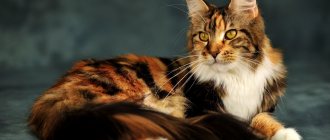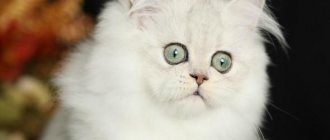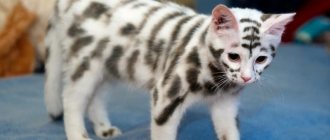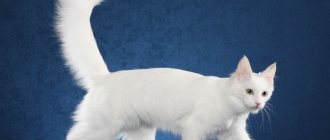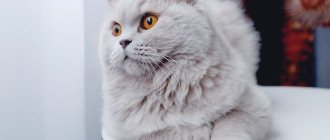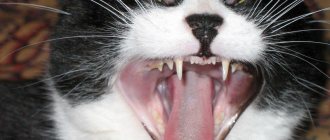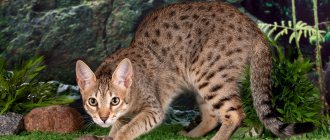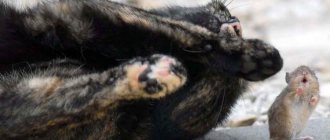The Yorkie Chocolate cat is a rare breed characterized by its rich dark brown coat color. It was obtained not purposefully, but by chance, but in just a quarter of a century it became known to the whole world.
The Chocolate Yorkie, as this beautiful breed is also called, is most widespread in North America, including the USA and Canada. In Russia, the popularity of this gorgeous cat is only gaining momentum.
Origin story
Back in 1983, the long-haired cat of American Janet Chifari gave birth to kittens.
The father of the offspring remained unknown, but he was clearly very attractive: one of the kittens stood out from all of them with its jet-black fur with a beautiful dark chocolate undercoat. His appearance impressed the animal owner so much that she started thinking about breeding a new breed. Through inbreeding, a bicolor white-brown cat and a bright chocolate cat were born. It was they who gave rise to a new breed, which received its name in honor of the city of New York and its amazing colors. The lack of skills and experience did not stop Chifari: she began to seriously study genetics, and eventually opened her own nursery. Her work was crowned with success: the gene responsible for the amazing chocolate color became stable and by June 1989 there were already more than 20 cats living in the nursery.
In the same year, the judge of the CFF felinological organization, Nancy Belser, was invited to the nursery. Having seen the unique cats with her own eyes, Nancy advised Chifari to take part in the CFF exhibition. From there the owner took away the first prize and even more enthusiasm. In 1990, the breed was awarded experimental status, and 2 years later – champion status. In 1995, the breed received recognition from the CCA and WCF organizations.
Today, European, American and Canadian nurseries are engaged in breeding York cats. In which the improvement of the breed is in full swing by injecting suitable “new” blood), in other countries (including Russia) “chocolates” are not so popular. But they have admirers here too.
Judging by the exterior, the breeds in the family of York cats were worthy. From the Siamese they got a brown color with a small amount of light inclusions, from the Persians they got long and thick fur.
Photo of a York Chocolate cat The York Chocolate cat is a large animal.
Females weigh on average 7-8 kg, males can reach 10, or even more, kilograms. Outwardly, it is very similar to the Persian breed. The York chocolate cat is a large animal. Females weigh on average 7-8 kg, males can reach 10, or even more, kilograms. Outwardly, it is very similar to the Persian breed.
| Standard | Description |
| Head | Medium size (but, in comparison with the body, may seem small), wedge-shaped, with a rounded forehead and an elegant neck line. |
| Ears | Large, continuing the wedge-shaped shape of the skull, with sharp tips, wide at the base and slightly inclined forward. There are many hairs inside the auricle. The ears are set wide apart: at least one ear must “fit” between them, otherwise it is considered a deviation from the standards. |
| Eyes | Oval, small, located at a slight angle towards the nose. Possible color: all shades of yellow (from golden to walnut green). The purer and deeper the shade, the higher the animal is rated. |
| Nose | Long, straight, even. A small depression at the level of the eye sockets is allowed. |
| Chin | Softly contoured but strong. With the upper lip and tip of the nose it forms a perfect vertical line. |
| Torso | Oblong and quite long, with smooth, smooth lines of paws and ribs. The bones are powerful and strong, as are the muscles. The chest is round and voluminous, cannot be wider than the hips. |
| Paws | The hind legs are sinewy, long, slightly longer than the front legs. The paw pads are large and oval in shape. The fur grows in tufts between the toes. |
| Tail | Wide, fluffy. Tapers towards the tip. |
| Wool | Silky to the touch, shiny, gently falls along the body. It is longer on the back than on the shoulders. The undercoat is abundant and should not be matted or coarse. If there is a fluffy “collar” on the collar, this is a “plus”. |
Tabby (stripes and spots) are allowed on the body of kittens (up to 10 months). In adult cats, white markings and medallions are considered faults and cause disqualification from competitions.
Breed defects
Chocolate breed cats are very healthy and are extremely rarely exposed to any diseases, especially if they have received all the necessary vaccinations. The maximum that can appear is caries, which can be avoided if you take care of your cat's teeth, and worms - any animal is susceptible to them, the problem is solved with the help of a tablet. The breed has no hereditary diseases, but has a strong immune system.
If after one and a half years the cat still has stripes or white spots, it will not be able to take part in exhibitions; the presence of white is considered a color defect.
Colors
The color should be uniform throughout the body. Tabbies, reddish and white spots, darkening in adult animals are not allowed.
Several types of color are allowed:
- Chocolate (the nose also has a dark brown color, and the inside of the ear and the pads on the paws are brown-pink);
- Lilac is a rich, cool lilac color. The nose is cocoa-colored, the inside of the ear and the pads are dark pink;
- Chocolate bicolor with milk - the color includes milk and chocolate colors, and the tail, back and head can be chocolate, and everything else can be white (belly, chest, lower part of the neck, hind and front legs). Spots on the face are allowed. The auricle is dark pink, the paw pads are light or dark pink. Nose – pink with a hint of chocolate;
- Lilac with white.
Photos of standard colors of a chocolate cat
Where to buy a dog?
There are several nurseries in Russia that specialize in breeding chocolates. You can also buy chocolate mini Yorkshire terriers. The photo is presented below.
The price starts from 50,000 rubles. The higher an animal is valued, the more expensive it is. The cost of the baby is not affected by the reluctance of the future owner to engage in breeding or attend exhibitions.
Character and behavior
When going to meet his future pet, a potential breeder thinks: what kind of character will he have? York cats – everything is at your fingertips!
These are extremely affectionate, loyal and gentle animals that get along well with humans. The York chocolate cat is able to adapt to almost any temperament, but she cannot stand loneliness even from the word “at all”! He is almost always in a good mood and loves affection. It is worth noting that tactile sensations are very important for a chocolate cat: stroking, scratching, gentle touches - the animal needs all this in large quantities.
If the cat understands that the owner is seriously busy, she will not demand attention by meowing or misbehave in the hope of attracting his attention. But walking “tail” from room to room - yes.
According to folk wisdom, what should happen if a cat washes itself?
Receive a letter Guests will come
He is loyal to children and is not averse to chasing a ball or chasing a bow on a string. But the claws will not be released, even if the child crosses the line of what is permitted.
But having another animal besides a chocolate cat is risky. No, you don’t have to worry about your dog or other cat: they will remain safe and sound. York will be reserved and polite: he will watch his new neighbor and come up to get to know him. But birds, fish or small rodents will be in danger: Yorkie cats have a five-point hunting instinct, and they will not fail to start their hunt.
The price of a chocolate cat is very high and starts at 25,000 rubles. The cost depends on gender (cats are more expensive), class, standard and pedigree. If the buyer wants to buy a kitten for himself, the price will be slightly lower than if he wanted to buy a baby for further breeding and participation in exhibitions.
Raising chocolate British kittens
Caring for a British cat requires careful attention from the owner. You need to raise a small kitten immediately after arriving in a new home, so that it learns its place in the new family. When educating, you should combine praise with severity. You can use affectionate conversation, petting, or giving cat treats as praise.
You can't be too strict with cats. Unlike dogs, they understand physical punishment less well. You cannot beat a kitten or an adult animal for wrongdoing. Cats do not understand the connection between punishment and wrongdoing. In response to punishment, they take offense at the owner and avoid his company. Wayward Britons can become aggressive.
Strictness in raising a cat means persistence. For example, a strict ban on climbing onto a countertop or visiting a certain room. Once a violation is detected, the animal must be expelled from the restricted area. When a cat plays pranks, it is acceptable to speak sternly to him. Trainable Britons will gradually understand how to behave correctly.
Care instructions
What does your pet need to live comfortably in your home?
- Individual bed according to size;
- scratching post;
- 2 bowls (for food and water);
- Tray with filler;
- Care products.
Wool
To ensure your pet's coat always looks perfect, you will have to brush it every 2-3 days. During the molting period - every day. You will need:
- Brushes: iron, bristle, rubber;
- Combined comb;
- Antistatic spray;
- Furminator;
- Regenerating spray for wool.
Sequencing:
- Spray the fur with an antistatic agent: this way it will not become electrified and cause discomfort to the animal.
- Carefully untangle the tangles, if any, and smooth the fur with a combination comb.
- Use a furminator, but not too often. Once a week is enough.
- Comb out excess hair first with an iron brush and then with a rubber brush.
Eyes
Yorkie cats' eyes do not “run”, but from time to time they will still have to be wiped with a cotton sponge soaked in a special lotion (the lotion can replace a fresh decoction of chamomile, 2% boric acid).
Ears
Ears are cleaned every week. A cotton swab is moistened with chamomile infusion or Vaseline, and the auricle is gently wiped from the inside. You can't bury anything inside!
Photo of a York Chocolate cat breed kitten
Purchasing a kitten
There are only a few nurseries with chocolate breeds in the whole world, most of them are located in America and Canada, a few in Europe. It is impossible to find a purebred Yorkie cat in Russia; if you suddenly see an advertisement, then most likely these are scammers who are offering a simple cat, passing it off as a purebred one.
If you decide to buy a purebred kitten, then find the nursery from which you want to adopt a pet. Read reviews about the nursery itself, study the conditions of detention. When choosing a kitten, do not forget to check all the necessary documents (kitten birth certificate or pedigree, veterinary passport, parent pedigrees), ask to see the kittens’ parents.
Before purchasing, carefully study all the information about the breed so that you can choose the best kitten. When choosing, look at the behavior of the kittens: a healthy kitten should be active and mobile. If your pet is sitting in a corner looking lethargic, then something is wrong with him. Look at the kittens' fur, it should be fluffy and shiny, and their eyes should not water. Kittens must be treated for fleas and worms; all these nuances must be noted in the veterinary passport along with vaccinations.
When choosing a kitten, you need to pay attention to its behavior and appearance.
It is best to adopt a kitten at about 1.5–2 months; it is at this age that the cat stops feeding her babies, the kittens begin to eat on their own and also go to the toilet on their own.
Catering
A balanced diet is the key to your pet’s health and long life. Under no circumstances should you give him leftovers from your table!
Recommended food
If you don’t have time to prepare food, stop at industrial feed. They are divided into 4 groups: economy, premium, super-premium and holistic.
Economy
They are characterized by an extremely poor composition: there is an abundance of plant components, but the percentage of by-products is small and their quality is questionable (residues from production, waste from slaughterhouses). But there is an excess of dyes, antioxidants, flavorings and preservatives.
Premium
Premium is slightly better than economy. Contains vegetable proteins, wheat or corn, antioxidants and preservatives (most often of unknown origin). They often cause allergies and are less easily absorbed by the body.
Super premium
Super-premium food has a balanced composition, more vegetables and meat ingredients and healthy additives. Samples: Summit, Pronature Life, Duke's Farm.
Holistic
Holistic is the best, but also the most expensive option. New generation food, made from natural raw materials using the latest technologies, balanced and without harmful ingredients. Samples: Innova Cat and Kitten, Acana, N&D.
Below are recommended super premium and holistic foods; links with food names are clickable. Using them, you can, within our website, read descriptions of food and read reviews from owners of the York Chocolate cat breed.
| Holistic | Holistic | Super premium |
| Savarra | Innova | Trainer |
Natural products
Let's say the following about natural nutrition. The presence of substances harmful to the cat (pesticides, GMOs, hormones), parasites and pathogenic bacteria is not allowed. Food must be fresh. 80% of the diet is proteins, followed by vegetable fats, carbohydrates (energy source), fiber (for digestion), trace elements and vitamins (calcium, iodine, selenium, magnesium).
Kittens up to 3 months are fed 6 times a day, from 3 to six months - 5 times, adolescents up to a year - 3 times, older ones - in the morning and in the evening.
- Sources of protein: meat (chicken, turkey, rabbit, veal, lamb - every day). Fresh or defrosted (boiled has practically no useful elements). Fish – no more than 2 times every 7 days. Raw quail, chicken or goose eggs (every 2 days); low-fat cottage cheese and kefir (every other day), natural unsweetened yoghurts, hard unsalted cheeses (once a week).
- Sources of fats: fats come with food, but you can additionally add fish oil to food (2 drops per porridge or vegetable oil in the same volumes).
- Fiber and carbohydrates: porridge (barley, oatmeal, liquid semolina), broccoli, pumpkin, cauliflower, apples, carrots, zucchini, green beans, cucumbers - every day.
- Minerals and vitamins: vitamin supplements (strictly on the advice of a veterinarian), brewer's yeast. Sprouted oats won't hurt.
It is forbidden to give cats:
- Baking;
- Fried, smoked, salted, spicy, sweet, pickled;
- Human canned food;
- Bones;
- Potato;
- Peas;
- Lamb, pork, duck;
- Freshwater fish;
- Lard, interior fat;
- White cabbage, tomatoes, eggplants;
- Whole cow's milk, tea, coffee, alcohol, carbonated drinks (including mineral water).
A chocolate cat should always have fresh water, clean and warm. Not from the tap, but filtered or boiled.
Expert opinion
Dusheba Vera Ivanovna
In 2010, she graduated from the Moscow State Academy of Veterinary Medicine named after K.I. Scriabin with honors, specializing in veterinary medicine. I regularly attend veterinary conferences, congresses, and webinars.
You cannot use the first cat you come across for breeding. Only 2 representatives of the breed are suitable: American Shorthair and Longhair. Males must have at least 3 exhibition titles, females - 1 and a couple of exhibitions under their belt. Pay attention to the pedigree, the presence of all vaccinations and treatments, and purebredness. Females are bred 2-3 times a year, carefully monitoring her health (additional vitamin supplements, changing her diet, regular doctor’s examinations).
Let's summarize
In the article we talked about such an unusual dog as the chocolate Yorkshire terrier. Its uniqueness lies in its rare color.
Let's highlight the main aspects:
- A standard Yorkie terrier weighs 3.2 kg. His mini-brother barely reaches 1.2 kg. Chocolate dogs come in both standard and mini.
- The cost of representatives of the rare color breed is high.
- They are no more demanding of care than any other Yorkshire Terrier.
- Pets are fed either dry food or natural food.
- Walk 3-4 times a day.
Diseases
Despite the fact that this breed was bred artificially, Yorkie chocolate cats rarely develop serious health problems. Their immunity is very resistant to both genetic and chronic diseases.
The most common ailments are related to the condition of the coat, teeth, ears and joints.
- Hair problems are immediately obvious. It becomes dull, shreds of it are found here and there. Dandruff, bald spots appear, and small rashes and traces of their vital activity appear on the skin. Most often, the reason is that the animal is infected with lice, lice or fleas. If your cat goes outside for a walk, there is a high risk of picking up parasites there. But pets are also under threat: you, without meaning to, can bring insects on clothes or shoes from the street.
- Symptoms of ear mites: brown plaque in the auricle. The parasite that has settled there feeds on dead cells and sulfur, gradually causing an inflammatory process and the occurrence of eczema. For treatment, the doctor prescribes antibiotics and rinses.
- Allergies in chocolate cats are not that rare. This is due to the fact that the owners do not adhere to the diet and feed the cat “at random”, from their table. Sometimes flea bites can also be the cause. The cat begins to scratch uncontrollably, blisters and eczema appear on the body. It is difficult to identify the disease on your own; only a doctor can do this. Treatment will consist of eliminating the allergen and supportive therapy (taking appropriate medications; wearing a flea collar).
- Symptoms of intestinal and stomach diseases: vomiting, diarrhea, refusal to eat, sudden loss of body weight, mucus or blood in the stool. The disease can be infectious (caused by parasites, viruses, bacteria) or non-infectious (tumor in the stomach or intestines, intestinal obstruction). Treatment is prescribed by a veterinarian depending on test results.
- A lot of bacteria accumulating in a cat's mouth leads to the formation of tartar on the teeth and inflammation of the gums. Regular teeth brushing and proper nutrition will help prevent the problem.
Expert opinion
Dusheba Vera Ivanovna
In 2010, she graduated from the Moscow State Academy of Veterinary Medicine named after K.I. Scriabin with honors, specializing in veterinary medicine. I regularly attend veterinary conferences, congresses, and webinars.
If you do not want to breed, spay or neuter your pet. The procedure can be carried out as soon as the cat is 6 months old. In cats - immediately after the first heat.
A dog for the soul
Many breeders do not like it when people ask them for a puppy “for themselves.” The worst thing is, maybe with a flaw. And they motivate this by the lack of money to buy a healthier animal or a gift for a child.
No breeder will sell a small dog as a living toy. The animal deserves love, care and good owners. And not picking out eyes, pulling the tail and twisting the paws.
Also, breeders will be wary of selling their puppies to people who do not have the money to buy a healthy baby. Buying a pet is just the initial expense. He needs quality nutrition, care and examination by a veterinarian. All this requires considerable sums. If a person cannot spend money on a good puppy, then where will he get it for its maintenance?
It is unlikely that a chocolate Yorkshire terrier will be cheap. There are Morkies, a mix of Maltese and Yorkies. Such dogs are similar in appearance to lap dogs, but they are sold as Yorkies.
As for free sites with advertisements for animals, no self-respecting breeder will place a purebred puppy of a rare color into good hands. On such a site you can stumble upon a cute brown mongrel, but not an elite dog.
Photo gallery
Below are photos of the York Chocolate cat breed.
kotocafe.rnd
ludmart.com.ua
nadezdabardasova
